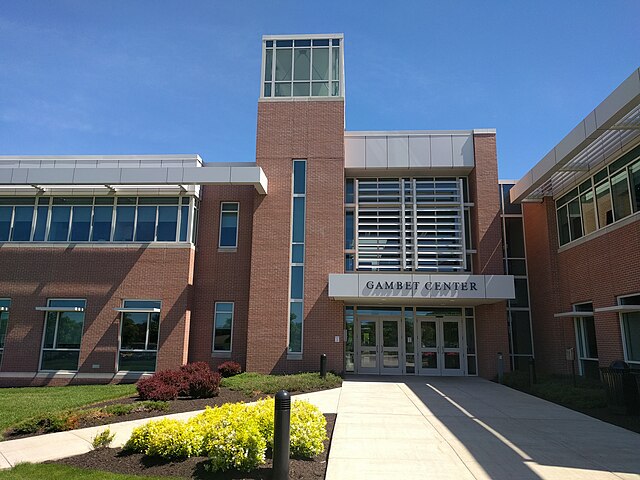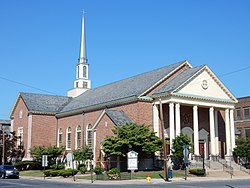Top Qs
Timeline
Chat
Perspective
Diocese of Allentown
Catholic ecclesiastical territory in Pennsylvania, U.S. From Wikipedia, the free encyclopedia
Remove ads
The Diocese of Allentown (Latin: Diœcesis Alanpolitana) is a diocese of the Catholic Church in the Lehigh Valley region of Pennsylvania in the United States. It is a suffragan diocese in the ecclesiastical province of the metropolitan Archdiocese of Philadelphia. The mother church of the Diocese of Allentown is the Cathedral Church of Saint Catharine of Siena in Allentown. The bishop is Alfred A. Schlert.

The Diocese of Allentown covers Berks, Carbon, Lehigh, Northampton and Schuylkill counties. As of 2025, the diocese had a registered population of 205,000 served by 78 parishes.[2]
Remove ads
History
Summarize
Perspective
18th century
Unlike the other colonies in British America, the Province of Pennsylvania did not ban Catholics from the colony or threaten priests with imprisonment. This was in part because the founder of the colony, William Penn, was a leading advocate of religious freedom. However Catholics who sought public office in the colony were required to take an oath to Protestantism.
The earliest Catholic mission in the Lehigh Valley was established in the 1720s in Goshenhoppen, whose residents came from a community in Philadelphia. The first resident priest arrived there in 1741. The mission would serve Catholics throughout the southeastern part of the British Province of Pennsylvania. During the Feast of Corpus Christi, some Protestant residents of Goshenhoppen mistook a Catholic procession for a military drill and complained to the colonial governor.[3]
During the French and Indian War, the colonial government prohibited Catholics from joining the colonial militia out of fear that their loyalties were with the French. However, during the American Revolution, many Pennsylvania Catholics served in the militias and colonial army. Catholic missionaries and army chaplains tended to wounded and sick American and French soldiers at a military hospital in Allentown. The first Catholic settlers in Allentown started arriving around 1763. For the next several decades, they were only seen by traveling priests.[4]
In 1784, a year following the end of the American Revolutionary War, Pope Pius VI erected the Apostolic Prefecture of United States of America, including all of the new United States.
In 1789, Pius VI converted the prefecture to the Diocese of Baltimore, covering all of the United States.[5] With the passage of the U.S. Bill of Rights in 1791, Catholics received full freedom of worship.[3]
19th century

After the discovery of anthracite coal in the region, Catholic immigrants started moving in to work in the mines and related industries. In 1836, the first Catholic parish in the Lehigh Valley, St. Bernard's, was erected in Easton in 1836.[6]
In the Hazleton area, the first Catholic church was constructed in Beaver Meadows in 1847.[7] The first Catholic church in Allentown was Immaculate Conception, dedicated in 1857.[4] In Bethlehem, the first Catholic church was Holy Infancy, which opened in 1861.[8]
20th century

In 1958, Alvernia College was founded in Reading by the Bernardine Franciscan Sisters.[9]
On January 28, 1961, the Diocese of Allentown was founded by Pope John XXIII with territory from the Archdiocese of Philadelphia. He appointed Auxiliary Bishop Joseph McShea of Philadelphia as the first bishop of the new diocese.[10]
During his 22-year tenure, McShea oversaw the construction, purchase, and renovation of over 300 church buildings. In 1964, McShea and the Oblates of St. Francis de Sales founded Allentown College; it is now DeSales University.[11] He convened the first diocesan synod in May 1968.
McShea also founded "Operation Rice Bowl", which began in the form of a small cardboard box in the parishes of the diocese to receive alms directed to relieving a famine in Africa. In 1976, it was adopted by the U.S. Conference of Catholic Bishops as a national program.[12] He founded Holy Family Manor, a nursing and rehabilitation center at Eugene Grace's former mansion in Bethlehem.[13] He also established Holy Family Villa, a retirement home for priests. McShea retired in 1983.
In 1983, Pope John Paul II named Bishop Thomas Welsh from the Diocese of Arlington as the second bishop of Allentown.[14]
Welsh established the first Youth Ministry Office in the diocese and raised $13 million in an endowment campaign for diocesan schools and other educational efforts,[15] improved relations between Catholics and Jews and founded both AD Times, a diocesan newspaper, and Catholic Distance University.[14] In 1997, Welch retired.
In 1998, Pope John Paul II appointed Auxiliary Bishop Edward Cullen of Philadelphia as the third bishop of the Diocese of Allentown.[16]
21st century
In 2004, Cullen revoked the celebration of mass and other sacraments at The National Centre for Padre Pio in Barto. Cullen had previously expressed concern over the center's fundraising practices and lavish salaries for family members managing the center.[17] The Centre appealed Cullen's ruling to the Vatican, which rejected its appeal.[18]
In 2008, Cullen closed 47 parishes in the diocese, reducing the total number from 151 to 104. Some of the closed churches were then sold.[19] Cullen retired in 2008.
In 2008, Pope Benedict XVI named Monsignor John Barres from the Diocese of Wilmington as the bishop of Allentown.[20] During his tenure, Barres established the Saint Thomas More Society for lawyers, and expanded the diocese's Hispanic ministry and evangelization.[21] In 2016, Barres was named bishop of the Diocese of Rockville Centre.
In 2016, Alfred Schlert was named by Pope Francis as bishop of Allentown.[22]
Remove ads
Bishops
Bishops of Allentown
- Joseph Mark McShea (1961–1983)
- Thomas Jerome Welsh (1983–1997)
- Edward Peter Cullen (1997–2009)
- John Oliver Barres (2009–2016), appointed Bishop of Rockville Centre
- Alfred A. Schlert (2017–present)
Other diocesan priests who became bishops
- Ronald William Gainer, appointed Bishop of Lexington in 2002 and later Bishop of Harrisburg
- Joseph Edward Kurtz, appointed Bishop of Knoxville in 1999 and later Archbishop of Louisville
- David B. Thompson, appointed Coadjutor Bishop of Charleston in 1989 and later Bishop of Charleston
Remove ads
Reports of sexual abuse
Summarize
Perspective
In 1972, the priest Thomas J. Bender was discovered by a Pennsylvania State Trooper sitting in a parked car with a student from Nativity High School. Both individuals were naked from the waist down. The trooper gave the two a lecture and released them. The incident was reported to the archdiocese. Bender remained in ministry. In 1984, a boy reported to the archdiocese that Bender had sodomized him. Bender admitted guilt to his superiors, but was allowed to stay in ministry. When the family threatened to sue and report Bender to police, the archdiocese sent him away for treatment. Bender pleaded guilty to sexual assault charges and was sentenced to probation. The archdiocese then granted him retirement. Other accusations of abuse surfaced in later years.[23]
In 1981, a parent reported to the archdiocese that his 12-year-old son had been sexually molested that day by Michael S. Lawrence, a priest at St. Catharine of Siena Parish in Mount Penn. The archdiocese removed Lawrence from the parish the next day and secured treatment for him. A year later, the archdiocese returned Lawrence to ministry. The family met with Bishop Walsh in 1994 to protest Lawrence remaining in ministry, but they said he was not interested in their complaints. In March 2002, Bishop Schlert met with the family and told them that Lawrence had been removed from ministry.[24]
Ronald J. Yarrosh, assistant pastor of St. Ambrose Catholic Church in Schuylkill Haven, was arrested in May 2004 on charges of possessing child pornography. Investigators found huge numbers of pornographic images, magazines, and DVDs in his rectory apartment. Yarrosh also embezzled $23,000 in parish funds. The archdiocese sent him to a treatment facility.[25] Yarrosh pleaded guilty and was sentenced to 23 months in prison.[26]
In early 2016, Pennsylvania Attorney General Josh Shapiro convened a grand jury investigation into the alleged sexual abuse of minors by Catholic clergy in six Pennsylvania dioceses, including the Diocese of Allentown.[27] That same month, the grand jury report named 37 priests in the diocese with credible accusations of sexual misconduct over several decades.[28] Bishop Schlert stated that the cases dated back decades and that most of the accused priests were dead or no longer active in the ministry. Schlert also said that the diocese had had a zero tolerance policy for sexual abuse since 2003.[29]
Shapiro criticized Schlert for his role in handling the sex abuse allegations.[30] Commenting on the grand jury report, Schlert noted that "much has changed in the past 15 years, notably, that the diocese immediately removes accused priests from ministry and reports allegations to law enforcement." The diocese removed three priests from ministry after the grand jury report was released; one was reinstated when the allegation was determined to be unfounded.[31]
The Pennsylvania grand jury report revealed copies of letters between Bishop Welsh and Bishop Leroy T. Matthiesen of the Diocese of Amarillo. The conversation was about a retired priest in Amarillo who was a recovering alcoholic. Welsh expressed concerns that the priest continue to be closely supervised. In 2002, the priest was arrested for abusing a 15-year-old boy.
In August 2018, Kevin Lonergan was charged with indecent assault and corruption of minors after inappropriately touching a 17-year-old girl and sending nude images of himself to her.[32] In February 2020, Lonergan was convicted and sentenced to time in prison.[33]
In May 2020, Timothy McGettigan, a former parishioner of St. Catharine of Siena Parish in Reading, sued the diocese. He said that he was sexually abused in the 1970s by Joseph Grembocki and David A. Soderlund, along with other priests he could not identify.[34] Soderlund was defrocked in 2005 and Grembocki died in 2016.[34] Though Soderlund was named in the Pennsylvania grand jury report, Grembocki was not.[34]
In August 2020, it was announced that the diocese had 20 new sex abuse lawsuits.[35]
Remove ads
Catholic education
Higher education
- Alvernia University – Reading
- DeSales University – Center Valley
High schools
As of 2025, the Diocese of Allentown operates six high schools:
Remove ads
References
External links
Wikiwand - on
Seamless Wikipedia browsing. On steroids.
Remove ads




